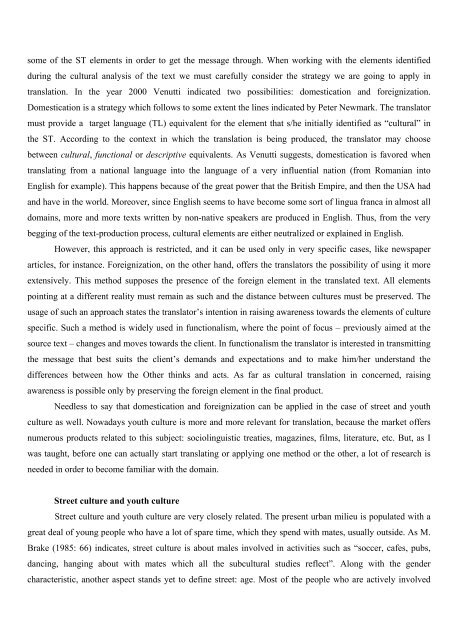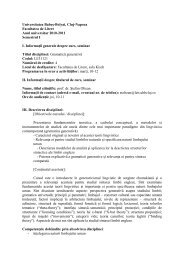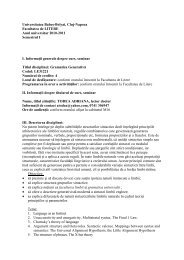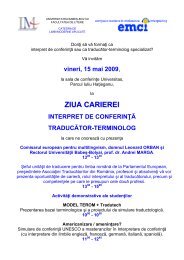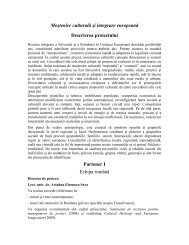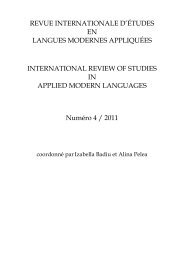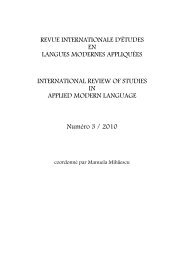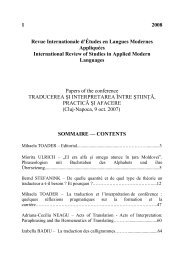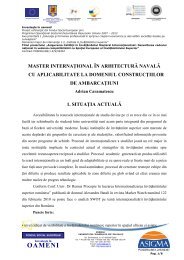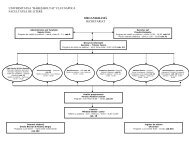Dimensiuni ale limbajului n context carceral
Dimensiuni ale limbajului n context carceral
Dimensiuni ale limbajului n context carceral
Create successful ePaper yourself
Turn your PDF publications into a flip-book with our unique Google optimized e-Paper software.
some of the ST elements in order to get the message through. When working with the elements identified<br />
during the cultural analysis of the text we must carefully consider the strategy we are going to apply in<br />
translation. In the year 2000 Venutti indicated two possibilities: domestication and foreignization.<br />
Domestication is a strategy which follows to some extent the lines indicated by Peter Newmark. The translator<br />
must provide a target language (TL) equiv<strong>ale</strong>nt for the element that s/he initially identified as “cultural” in<br />
the ST. According to the <strong>context</strong> in which the translation is being produced, the translator may choose<br />
between cultural, functional or descriptive equiv<strong>ale</strong>nts. As Venutti suggests, domestication is favored when<br />
translating from a national language into the language of a very influential nation (from Romanian into<br />
English for example). This happens because of the great power that the British Empire, and then the USA had<br />
and have in the world. Moreover, since English seems to have become some sort of lingua franca in almost all<br />
domains, more and more texts written by non-native speakers are produced in English. Thus, from the very<br />
begging of the text-production process, cultural elements are either neutralized or explained in English.<br />
However, this approach is restricted, and it can be used only in very specific cases, like newspaper<br />
articles, for instance. Foreignization, on the other hand, offers the translators the possibility of using it more<br />
extensively. This method supposes the presence of the foreign element in the translated text. All elements<br />
pointing at a different reality must remain as such and the distance between cultures must be preserved. The<br />
usage of such an approach states the translator’s intention in raising awareness towards the elements of culture<br />
specific. Such a method is widely used in functionalism, where the point of focus – previously aimed at the<br />
source text – changes and moves towards the client. In functionalism the translator is interested in transmitting<br />
the message that best suits the client’s demands and expectations and to make him/her understand the<br />
differences between how the Other thinks and acts. As far as cultural translation in concerned, raising<br />
awareness is possible only by preserving the foreign element in the final product.<br />
Needless to say that domestication and foreignization can be applied in the case of street and youth<br />
culture as well. Nowadays youth culture is more and more relevant for translation, because the market offers<br />
numerous products related to this subject: sociolinguistic treaties, magazines, films, literature, etc. But, as I<br />
was taught, before one can actually start translating or applying one method or the other, a lot of research is<br />
needed in order to become familiar with the domain.<br />
Street culture and youth culture<br />
Street culture and youth culture are very closely related. The present urban milieu is populated with a<br />
great deal of young people who have a lot of spare time, which they spend with mates, usually outside. As M.<br />
Brake (1985: 66) indicates, street culture is about m<strong>ale</strong>s involved in activities such as “soccer, cafes, pubs,<br />
dancing, hanging about with mates which all the subcultural studies reflect”. Along with the gender<br />
characteristic, another aspect stands yet to define street: age. Most of the people who are actively involved


